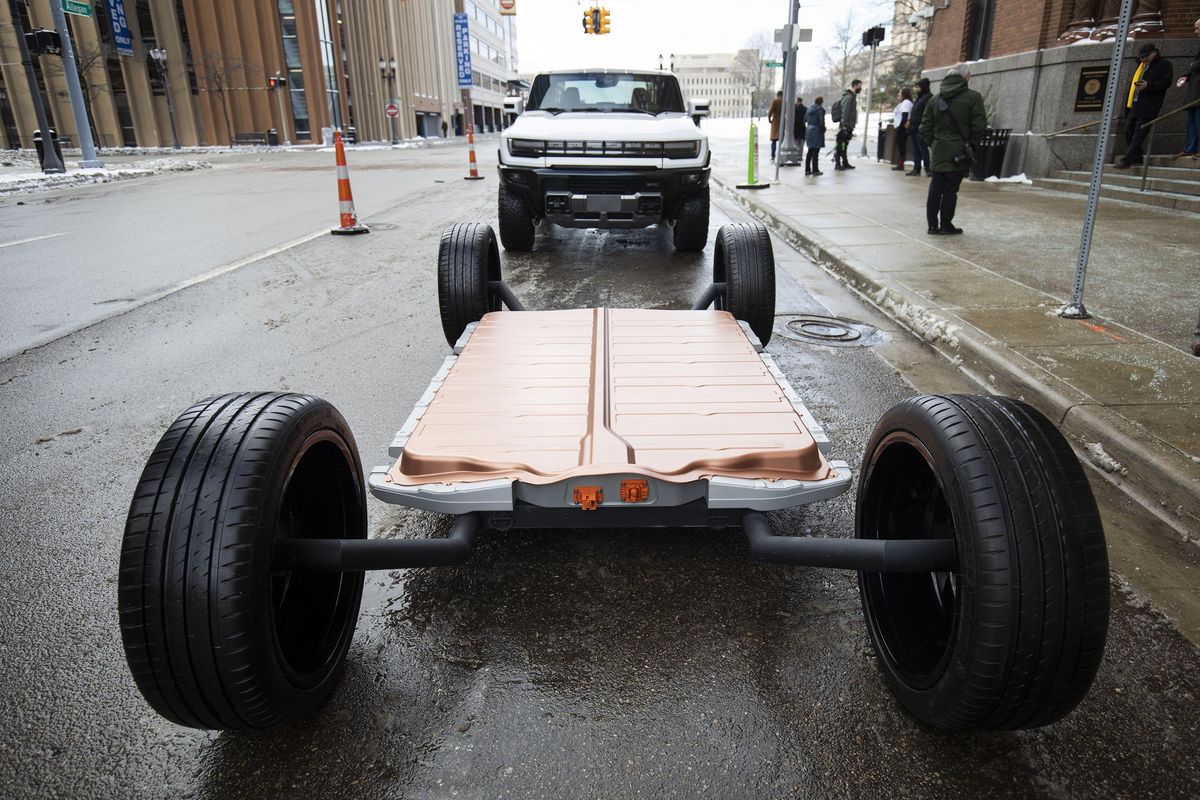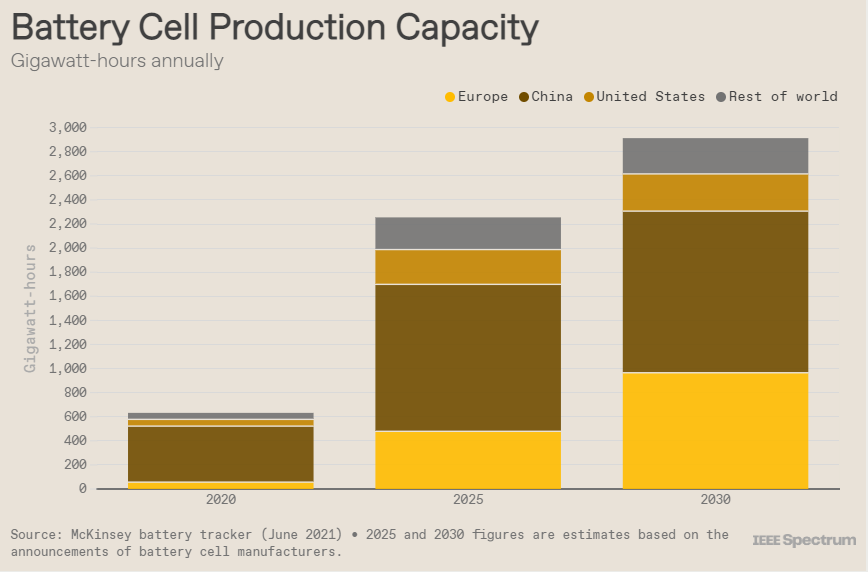
A General Motors Hummer EV chassis sits in front of an Hummer EV outside an event where GM CEO Mary Barra announced a US $7 billion investment in EV and battery production in Michigan in January 2022. BILL PUGLIANO/GETTY IMAGES
Electric vehicles at scale alter the terms of both basic currencies concurrently. Reliable, secure supplies of minerals and software are core elements for EVs, which represent a “shift from a fuel-intensive to a material-intensive energy system,” according to a report by the International Energy Agency (IEA). For example, the mineral requirements for an EV’s batteries and electric motors are six times that of an internal-combustion-engine (ICE) vehicle, which can increase the average weight of an EV by 340 kilograms (750 pounds). For something like the Ford Lightning, the weight can be more than twice that amount.
EVs also create a shift from an electromechanical-intensive to an information-intensive vehicle. EVs offer a virtual clean slate from which to accelerate the design of safe, software-defined vehicles, with computing and supporting electronics being the prime enabler of a vehicle’s features, functions, and value. Software also allows for the decoupling of the internal mechanical connections needed in an ICE vehicle, permitting an EV to be controlled remotely or autonomously. An added benefit is that the loss of the ICE power train not only reduces the components a vehicle requires but also frees up space for increased passenger comfort and storage.
The effects of Simon’s profound changes” are readily apparent, forcing a 120-year-old industry to fundamentally reinvent itself. EVs require automakers to design new manufacturing processes and build plants to make both EVs and their batteries. Ramping up the battery supply chain is the automakers’ current “most challenging topic,” according to VW chief financial officer Arno Antlitz.
It can take five or more years to get a lithium mine up and going, but operations can start only after it has secured the required permits, a process that itself can take years.
These plants are also very expensive. Ford and its Korean battery supplier SK Innovation are spending US $5.6 billion to produce F-Series EVs and batteries in Stanton, Tenn., for example, while GM is spending $2 billion to produce its new Cadillac Lyriq EVs in Spring Hill, Tenn. As automakers expand their lines of EVs, tens of billions more will need to be invested in both manufacturing and battery plants. It is little wonder that Tesla CEO Elon Musk calls EV factories “gigantic money furnaces.”
Furthermore, Dziczek adds, there are scores of new global EV competitors actively seeking to replace the legacy automakers. The “simplicity” of EVs in comparison with ICE vehicles allows these disruptors to compete virtually from scratch with legacy automakers, not only in the car market itself but for the material and labor inputs as well.
Batteries and the supply-chain challenge
Another critical question is whether all the planned battery-plant output will support expected EV production demands. For instance, the United States will require 8 million EV batteries annually by 2030 if its target to make EVs half of all new-vehicle sales is met, with that number rising each year after. As IEA executive director Fatih Birolobserves, “Today, the data shows a looming mismatch between the world’s strengthened climate ambitions and the availability of critical minerals that are essential to realizing those ambitions.”
This mismatch worries automakers. GM, Ford, Tesla, and others have moved to secure batteries through 2025, but it could be tricky after that. Rivian Automotive chief executive RJ Scaringe was recently quoted in the Wall Street Journal as saying that “90 to 95 percent of the (battery) supply chain does not exist,” and that the current semiconductor chip shortage is “a small appetizer to what we are about to feel on battery cells over the next two decades.”
The competition for securing raw materials, along with the increased consumer demand, has caused EV prices to spike. Ford has raised the price of the Lightning $6,000 to $8,500, and CEO Jim Farley bluntly states that in regard to material shortages in the foreseeable future, “I don’t think we should be confident in any other outcomes than an increase in prices.”
The underlying reason for the worry: Supplying sufficient raw materials to existing and planned battery plants as well as to the manufacturers of other renewable energy sources and military systems—who are competing for the same materials—has several complications to overcome. Among them is the need for more mines to provide the metals required, which have spiked in price as demand has increased. For example, while demand for lithium is growing rapidly, investment in mines has significantly lagged that which has been aimed toward EVs and battery plants. It can take five or more years to get a lithium mine up and going, but operations can only start after it has secured the required permits, a process that itself can take years.
Mining the raw materials, of course, assumes that there is sufficient refining capability to process them, which outside of China, is limited. This is especially true in the US, which according to a Biden Administration special supply chain investigative report, has “limited raw material production capacity and virtually no processing capacity.” Consequently, the report states that the US “exports the limited raw materials produced today to foreign markets.” For example, output from the only nickel mine in the US, the Eagle mine in Minnesota, is sent to Canada for smelting.
“Energy and information are two basic currencies of organic and social systems. A new technology that alters the terms on which one or the other of these is available to a system can work on it the most profound changes.” —Herb Simon
One possible solution is to move away from lithium-ion batteries and nickel-metal hydrides batteries to other battery chemistries such as lithium-iron phosphate, lithium-ion phosphate, lithium-sulfur, lithium-metal, and sodium-ionamong many others, not to mention solid-state batteries, as a way to alleviate some of the material supply and cost problems. Tesla is moving towards the use of lithium-iron phosphate batteries, as is Ford for some of its vehicles. These batteries are cobalt free, which alleviates several sourcing issues.
Another solution may be recycling both EV batteries as well as the waste and rejects from battery manufacturing, which can run between 5 to 10 percent of production. Effective recycling of EV batteries “has the potential to reduce primary demand compared to total demand in 2040, by approximately 25% for lithium, 35% for cobalt and nickel and 55% for copper,” according to a report (pdf) by the University of Sidney’sInstitute for Sustainable Futures.

While investments into creating EV battery recycling facilities have started, there is a looming question of whether there will be enough battery factory scrap and other lithium-ion battery waste for them to remain operational while they wait for sufficient numbers of batteries to make them profitable. Lithium-ion battery pack recycling is very time-consuming and expensive, making mining lithium often cheaper than recycling it, for example. Recycling low or no-cobalt lithium batteries which is the direction many automakers are taking may also make it unprofitable to recycle them.
An additional concern is that EV batteries, once no longer useful for propelling the EV, have years of life left in them. They can be refurbished, rebuilt and reused in EVs, or repurposed into storage devices for homes, businesses or the grid. Whether it will make economic sense to do either at scale versus recycling them, remains to be seen.
Howard Nusbaum, the administrator of the National Salvage Vehicle Reporting Program (NSVRP), succinctly puts it, “There is no recycling, and no EV recycling industry, if there is no economic basis for one.”